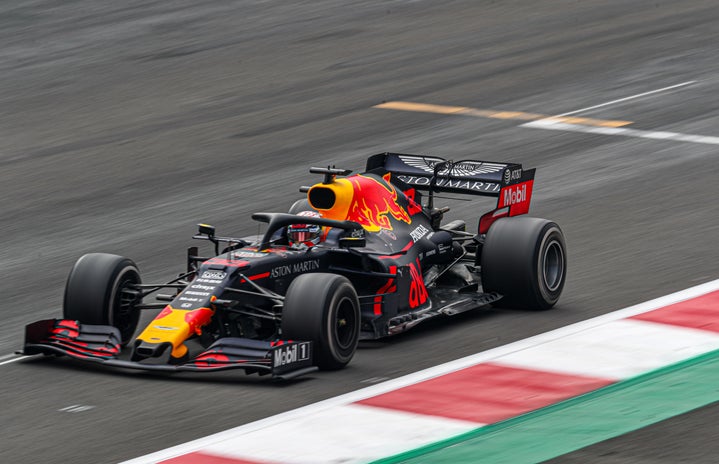Formula 1 (F1), the apex of motorsport, is the highest class and the world’s most prestigious international racing competition.
Honestly, before 2024, that sentence would have meant nothing to me. A sport where cars go fast? That’s literally just me going to Target on a Saturday. However, at the beginning of 2024, I decided it was finally time that I understood the sport (partly due to it being all over my explore page). Four months later, here we are, and I haven’t stopped talking about F1 since.
So, what exactly is F1?
With 20 drivers, cars that go 200 mph, and 1.5 billion annual viewers, F1 is unlike any other sport. It’s the embodiment of high-class international car racing. The complexity behind this sport causes many to describe it as a space program for automobile innovation. But how can it do all of that? How can F1 be car racing, a space program, and entertaining?
the cars
The Formula 1 cars — some of the most advanced in the world — are specially built by each team to optimize speed, handling, and aerodynamics. Millions of dollars go toward the engineering and development of the cars, so much so that the budget was set at $135 million per team in 2023. As you can imagine, F1 cars aren’t the typical cars you’ll see driving down the street.
The cars of F1 racing are the essence of the sport. If you’re not a car girlie, don’t worry. You can still enjoy F1 races without fully understanding how the cars work (because trust me, it gets confusing). However, it’s important to know the role that they serve in the race! The cars themselves act as upside-down airplanes, with wings in the front and rears that push the car down and keep it gripped to the track around fast corners.
The amount of engineering, testing, and research put into each F1 car makes it incomparable to any other sport. Not only does each car have to fit its individual driver, but it also has to be able to reach high speeds while simultaneously staying gripped to the track. Due to this, the cars are constantly being improved and are designed differently for each team.
Fun fact: The car designers paint any designs you see onto the car itself because adding a sticker could cause the slightest amount of drag, preventing the car from going faster!
the teams
F1 is currently composed of 10 teams, each having two drivers. Ferrari, McLaren, and Redbull are a few of the most popular teams. In addition to the two drivers, the teams also consist of a much larger population of engineers, strategists, and designers who actively work with the drivers to strategize the best ways to win.
As a fan, learning about the teams has been my favorite part. Thankfully with all of the media that each team produces, it’s very easy to experience how personable each driver can be. From YouTube videos to Instagram Reels, the teams are very involved with social media, and I’m obsessed with it (Lando Norris, please follow me back).
a typical grand prix weekend
Throughout the F1 season, there are typically somewhere from 20 to 24 races, with 24 for the 2024 season. From the Middle East to Japan to the United States, F1 hosts Grand Prix (races) in famous cities all around the globe.
A typical Grand Prix weekend lasts three days: Friday, Saturday, and Sunday. The Friday of that week starts the weekend strong with two Free Practice sessions, also known as Free Practice 1 (FP1) and Free Practice 2 (FP2). These practice sessions normally run for 60 minutes each and are done to guarantee that the car is functioning properly before the race.
On Saturday, there’s one final practice session (FP3) followed by three qualifying rounds. Qualifying 1 (Q1) is 18 minutes and eliminates the five slowest drivers. In Qualifying 2 (Q2), five more of the slowest drivers are eliminated in a 15-minute session. Lastly, in Qualifying 3 (Q3), the top 10 grid slots get decided in a final, 12-minute-long, session. With the qualifying rounds setting up their grid slots for race day, the first position, also known as the pole position, is set for the fastest driver (insert intro of “33 Max Verstappen” by Carte Blanq and Maxx Power).
Sunday is racing day! F1 races typically last around an hour-and-a-half to two hours depending on how the race goes. The distance of each race is dependent on a set number of laps that is based on the length of the circuit (the track). If you can’t go to the race yourself, you can watch on the Formula 1 or ESPN app.
the championship
At this point, you might be wondering what they’re competing for. Honestly, when I got into F1, I was too.
One of the most interesting parts of F1 is that there are not only one but two championships that drivers compete in simultaneously. The most obvious championship is the Drivers’ Championship, which each driver competes for. However, there is also the Constructors’ Championship, which awards the team with the most accumulated points.
From the aesthetics to the actual racing itself, Formula 1 is my favorite sport overall. After reading this, I hope that it becomes yours too! Now that you understand some of the basics of the sport, I hope that your F1 viewing is a little less daunting and a lot more fun!
If you’re interested in learning more about F1, I highly recommend Cleo Abram on YouTube, as well as the official F1 YouTube account. And shoutout to all of my friends who have had to hear me talk nonstop about F1 since I learned about it; y’all are so real for that.
Want to see more HCFSU? Be sure to like us on Facebook and follow us on Instagram, Twitter, TikTok, and Pinterest!


